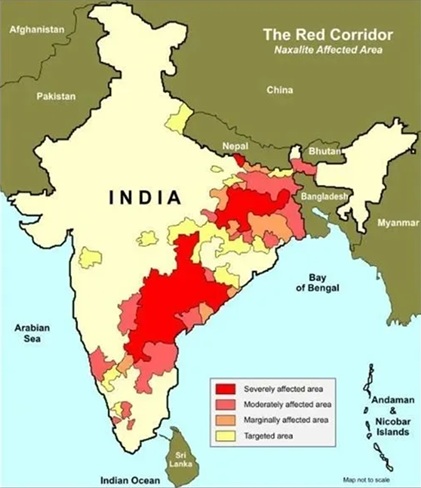| (Mains, General Studies Paper-3: Role of anti-state elements posing internal security challenges) |
Reference
Recent data from the Ministry of Home Affairs show a sharp decline in Left Wing Extremism (LWE)-induced violence across India, a significant shift in the decades-long Naxalite insurgency.

Rise of Naxalism
- Origin: Naxalbari rebellion (1967, West Bengal)
- Demand for land redistribution, tribal rights and anti-state revolutionary politics inspired by Maoism.
- Spread: Tribal-dominated ‘Red Corridor’ (Jharkhand, Chhattisgarh, Odisha, Maharashtra, Andhra Pradesh).
- Peak: Early 2000s – Naxalites active in 223 districts of 20 states.
Causes of Naxalism
- Land acquisition and displacement of tribals due to mining, dams, industrial projects
- Weak governance and poverty in tribal areas
- Exploitation and lack of rights under forest laws
- Ideological mobilization for social justice and anti-state struggle
Reasons for decline in Naxalism
- Security measures: Coordinated operations like Operation Green Hunt, fortification of security camps, modern weapons, drones
- Development initiatives: Construction of roads, telecom, schools, health centres in LWE affected districts
- Surrender and rehabilitation policies: Incentives for ex-militants, livelihood schemes
- Community participation: Withdrawal of support to Naxalites by locals
- Political will: State-Centre coordination, National Investigation Agency (NIA) monitoring financial and urban Maoist networks
Current scenario
- LWE affected districts reduced from 223 (2008) to 45 (2023).
- Civilian and security personnel deaths at record low
- Violence is now mainly confined to parts of Bastar (Chhattisgarh) and Gadchiroli (Maharashtra).
Challenges
- Remaining Naxal strongholds with inaccessible terrain.
- Socio-economic problems (tribal land, displacement).
Solutions
- Security approach needs to be balanced with development and rights-based governance.
- A balanced ‘security, development and rights’ approach must be adopted to ensure permanent end to Naxalism and inclusion of tribal areas into mainstream governance.



